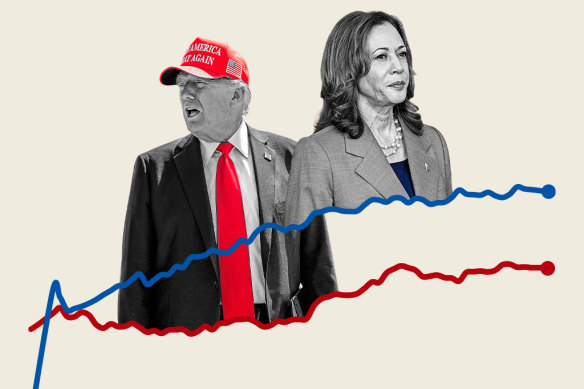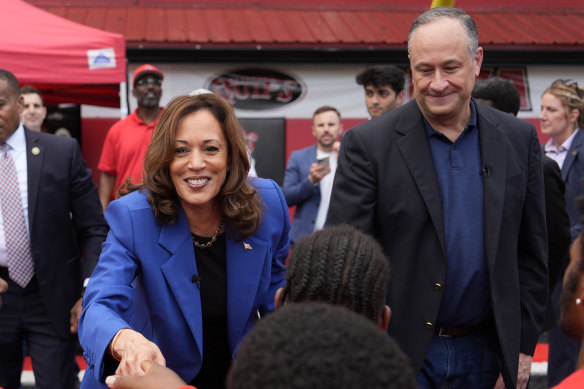Harris v Trump: Could we see a 270-268 election? Polls say it’s possible
By Nate Cohn
Last week, we concluded our wave of New York Times/Siena College post-debate polls in the battlegrounds, along with a special look at Ohio and its Senate race.
Vice President Kamala Harris led among likely voters by 1 percentage point in Michigan, 2 points in Wisconsin and 9 points in Nebraska’s 2nd Congressional District. Former president Donald Trump led in Ohio by 6 points among likely voters, 50 per cent to 44 per cent. (He won the state by 8 points in 2020.)

The latest polls put Trump and Harris neck and neck.Credit: Marija Ercegovac
When you add the other recent Times/Siena polls to the picture, the takeaway is clear: this is an extremely close election.
Imagine, for a moment, that the latest Times/Siena polls in every key state were right on the mark. They won’t be, of course, but here’s the result you would get in the Electoral College:
Harris 270, Trump 268.
In terms of the electoral count, it would be the closest modern US presidential election.
If you average the six polls we did in core battleground states (we skipped Nevada in our most recent round), Trump led by an average of just 0.6 of a point.
We’ve had a lot of close elections in recent memory, but in none of them were the polls so close. In each of the 2008, 2012, 2016 and 2020 elections, a candidate led by at least a few points in enough states to make one candidate a material, if not overwhelming, favourite.
As Hillary Clinton can attest, a modest but clear lead is not a guarantee of victory. But here, neither Harris nor Trump can claim even that.
This may be a year when the polls won’t suggest that any candidate is a favourite.
Looking back at Pennsylvania
Let’s step back and look at where these six states stand, comparing the presidential result in 2020 in each with the latest Times/Siena poll:
— Pennsylvania (Joe Biden +1.2 in 2020): Harris +4
— Wisconsin (Biden +0.6): Harris +2
— Michigan (Biden +2.8): Harris +1
— North Carolina (Trump +1.3): Trump +3
— Georgia (Biden +0.2): Trump +4
— Arizona (Biden +0.3): Trump +5
Of these Times/Siena polls, the Pennsylvania survey stands out as Harris’ best result. Nowhere else is she running so far ahead of Biden’s 2020 performance, and no state is more important.
Unlike in other states, we began our survey in Pennsylvania the night after the debate. As I mentioned in our write-up at the time, there were a few hints that the results were a little too favourable for Harris.

Democratic presidential nominee Kamala Harris and her husband, Doug Emhoff, greet members of the Aliquippa High School football team in Pennsylvania.Credit: AP
With memories of the debate fading and subsequent results looking stronger for Trump, it makes one wonder if a Times/Siena poll today would show a closer race there.
We’ll be back in the field in Pennsylvania at some point next month.
Democrats downballot: Ohio
The competitive Senate races keep coming up blue in our polling.
Democratic Senate candidates led in Michigan, Wisconsin and, yes, even Ohio, where Sherrod Brown led by 4 points over Republican Bernie Moreno, 47 per cent to 43 per cent.

Polling strength in sunbelt states: Republican presidential nominee former president Donald Trump speaks.Credit: AP
If the poll is right, Moreno will need more than undecided Trump voters to break his way. Brown would still lead by two points, 50-48, if voters who are currently undecided in the Senate race chose the candidate who aligns with the party of their presidential vote choice. Instead, Brown leads because he has the support of 10 per cent of Trump’s backers. To win, Moreno will need to pull some of that support back.
Given Brown’s dependence on Trump voters, this race could easily tighten – or perhaps even turn red by November. Two years ago, the Senate race between J.D. Vance and Tim Ryan was close at this stage, but Vance pulled ahead down the stretch. It’s not hard to imagine a repeat.
Despite that 2022 win, Vance does not appear to be a home-state hero. Overall, 45 per cent of voters in his home state say they have a favourable view of him, compared with 47 per cent unfavorable. That’s no better than Ohio’s view of the Democratic vice-presidential nominee, Tim Walz, who is at 41 per cent favourable and 42 per cent unfavorable.
Democrats downballot: Nebraska
As mentioned earlier, Harris would win 270 electoral votes – exactly the number needed to win – if the Times/Siena polls were precisely right.
But this is only the case because Nebraska does not award its five electoral votes on a winner-takes-all basis; instead, the winner statewide receives two votes while the winner of each congressional district receives one. Thanks to this quirk, Harris is expected to win one additional electoral vote, as she has a big lead in our poll of Nebraska’s 2nd District, which encompasses Omaha.
In recent weeks, Republican politicians made a last-minute effort to change the rules and award Nebraska’s electoral votes on a winner-takes-all basis. The effort seems to have failed; if the Times/Siena polling is any indication, there’s a chance it may have backfired as well.
In the race for US House, Democrat Tony Vargas leads Republican incumbent Don Bacon by 3 points, 49 to 46.
There’s also a race for US Senate worth considering: between the Republican incumbent, Deb Fischer, and an independent candidate, Dan Osborn. Several statewide polls in Nebraska have shown a close race between the two, even though Trump won the state by 19 points in 2020.
The Times/Siena poll covers only one-third of the state’s voters, but it shows Osborn ahead by 11 points, 49 to 38. That’s certainly better than Biden’s six-point win in this district four years ago, but it’s well short of the 19-point over-performance (or about a 25-point lead in this district) that he would need to win statewide.
If this poll is correct, the burden on him to perform well elsewhere in the state is considerable.
This article originally appeared in The New York Times.
Get a note directly from our foreign correspondents on what’s making headlines around the world. Sign up for the weekly What in the World newsletter here.